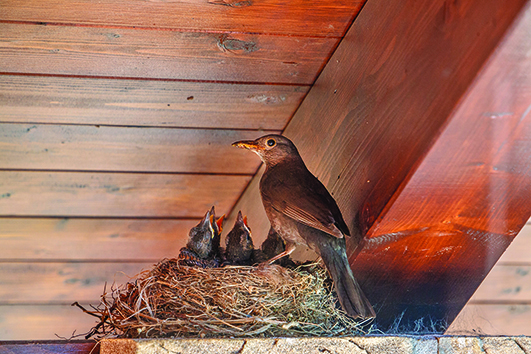
A popular and pesky spot that birds choose to nest, such as this mother blackbird and her chicks, are the corners of a porch or garage roof.
A popular and pesky spot that birds choose to nest, such as this mother blackbird and her chicks, are the corners of a porch or garage roof.
There’s something so fascinating about finding a bird’s nest as a child.
A little home crafted by birds using bits of nature to house baby birds created with merely beaks and tiny feet is one of life’s little wonders. While there may still be some element of surprise finding one as an adult, you might find at times a nest in an inconvenient spot.
Settling in an old tool box, making their home in your garage rafters, occupying an old boot left outside — there’s countless stories of finding something peculiar and before you can pinpoint why there is a grass-like something in your old planter — out flies momma bird!
Why do our feathered friends pick places like this? There is a pattern to these hot spots. Birds look for spaces that are hidden, but still with good vantage points. They also need “good bones” to form a nest on, like the spines of a patio umbrella or the inner curve of your front door wreath, making them very popular spots. Other birds, such as wrens, look for pockets of spots where they can make their nests actually in something. And yes, sometimes these pocket-type spots are indeed actual pockets.
Another popular and pesky spot are the corners of a porch or garage roof from birds such as swallows, who create those mud looking nests using bird saliva. (The bird saliva is also a delicacy in China used for “bird’s nest soup” but no need to go into logistics on how they collect it.)
While birds do seek out trees to settle in, sometimes a natural spot isn’t available and they must pick a “human” space. This is especially the case in a yard where there might not be established trees and shrubbery.
To help keep nature and its nests at a proper distance, start to keep an eye out in the early spring for nests beginning to appear as the birds get serious about their family plans. Per the Migratory Bird Treaty Act of 1918, it’s illegal to move an active bird nest- meaning one where momma is brooding or sitting on the nest or if there are eggs in it so intervention can be key.
Proactively guide them to different areas before they start. Try setting up a fake “guard” or predator using a decoy of an owl, large bird, cat or other stern looking critter in an area such as your porch, where you wouldn’t want a swallow darting at you while you sip your sweet tea. Birds are clever though, so make sure you move the decoy around or they’ll realize security is asleep on the job.
Another way to set up a fake watchman is dangling a reflector from string or twine, which will imitate a predator’s eyes at night, lurking around.
For a more definitive and deterrent, netting will also work when stapled discreetly near gaps in a barn roof or corner area. Just make sure the netting you select is fine enough that their delicate feet won’t get stuck. Or if the area allows, try filling the space with bricks or rocks.
You may have also heard of something called a “bird spike.” While they sound like something you’d use to build your own Alcatraz, all they really are is clear plastic spikes that are ideal for roofs, lights, sills or anywhere you can attach them. They don’t hurt the birds, rather they deter the birds from attempting to land in the first place.
For large spaces like gutters that can be attractive because of their open yet narrow area, try a bird repellent gel, which you can apply using a caulk gun. While applying the gel is something that you would need to add to your annual outside housekeeping, it can be worth it if you consistently have your gutters jammed with nests.
If despite your preparedness you find a nest managed to slip past you, in the majority of cases you’ll have to suck it up and bear it. But do rest assured, many birds don’t use their nests long. Cardinal babies are ready to leave the nest in 9-11 days after hatching. In extreme cases of poor placement, you could call a professional rescue or pest control company who has a permit to move a nest in certain circumstances.
Hand-in-hand with preventing nests, you can also assist your backyard buddies to build where you’d be happy to have them.
Something fun to do, especially with little ones, could be to see what building supplies you can put out for birds to incorporate into their nests.
If you are brushing your fluffy and furry pets or getting your haircut, let the hairball blow away and see if it ends up in a nest anywhere! You could also set out small bits of embroidery thread or yarn (short enough that it doesn’t wrap around their feet) on tree limbs to see if a bird chooses to create a colorful nest. If you have chickens, you may notice that feathers, especially the soft downy ones, may get chosen for a nest as well. One thing to not include is dryer lint.
You can let these items go in the wind to find a home or create a little stash using something like a suet feeder, whisk or anything with open wires for them to grab from.
Another possible kids craft is collecting supplies and then try to make your own nest. It will make you appreciate how birds can create a home using their tiny beaks and feet.
By setting a few boundaries, you and your backyard birds can both sing in harmony.





